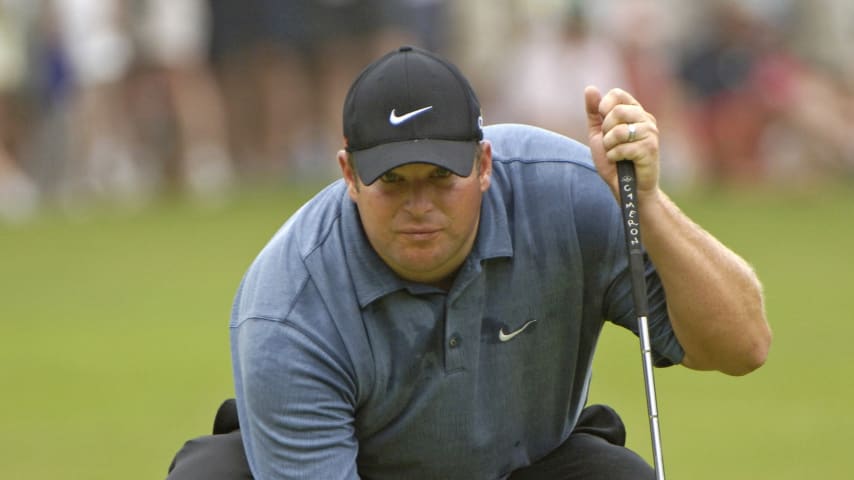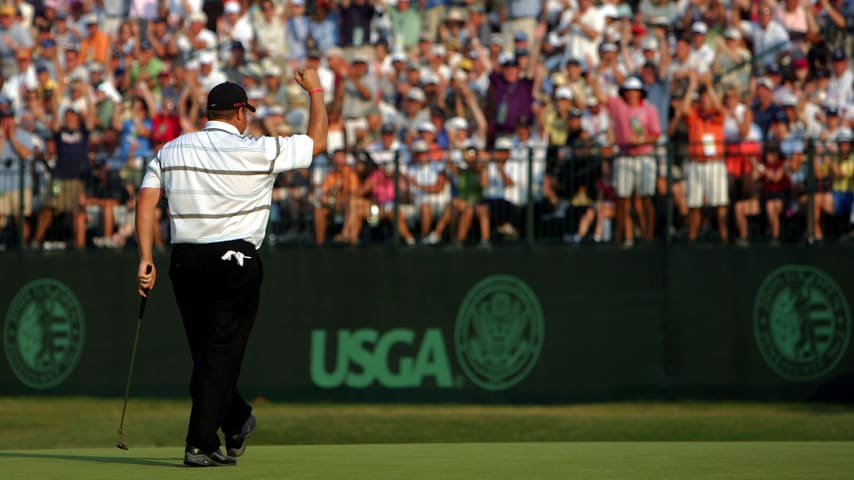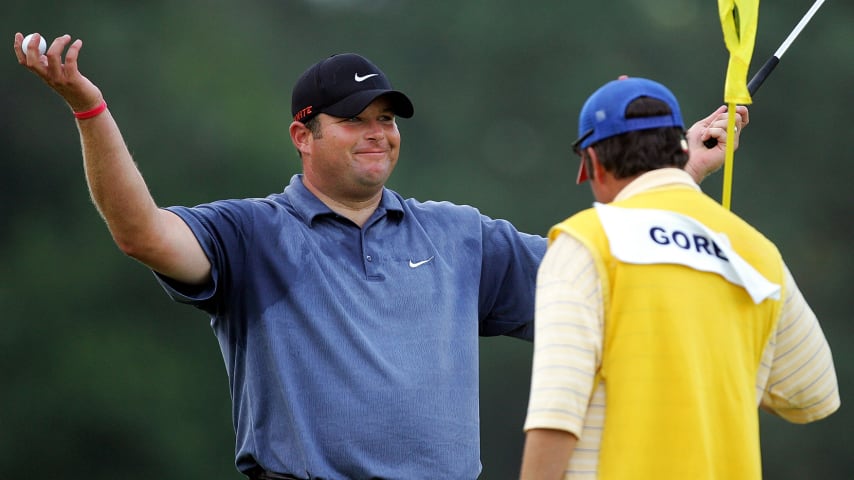Jason Gore looks back at unprecedented 2005 U.S. Open run at Pinehurst
12 Min Read

Jason Gore studies a putt during the final round of the 2005 U.S. Open Golf Championship at Pinehurst Resort course 2 in Pinehurst, North Carolina on June 19, 2005. (Photo by S. Badz/Getty Images)
Written by United States Golf Association
This content originally appeared on USOpen.com. Follow all the action, scores and insights from the 124th U.S. Open at Pinehurst Resort & Country Club (Course No. 2) at USOpen.com.
In 2005, Jason Gore made a Cinderella run at the U.S. Open at Pinehurst Resort & Country Club’s Course No. 2. Gore was a regular on what is now known as the Korn Ferry Tour, and after three rounds, the Southern California native found himself in the final pairing with two-time U.S. Open champion Retief Goosen. In this lookback, Gore chats about what it was like to find himself on the biggest stage in his career and what it takes to succeed at a Pinehurst U.S. Open.
Editor's note: After a final-round 84 at the 2005 U.S. Open, playing in the final group, Gore won three consecutive Korn Ferry Tour starts the following month to earn a Three-Victory Promotion to the PGA TOUR. To this date, no other player has won three straight Korn Ferry Tour starts.
On the second day of the 2005 U.S. Open
I remember playing the ninth hole on Friday very clearly. No. 9 is this testy par 3. It was kind of into the wind. And what do I do? I chunk 6-iron. Hit the top of the clubface and watch as the ball balloons into the wind. When it landed, I heard the thud in front of the green and then remember the ball rolling into the bunker short. This was a classic Pinehurst situation: ball on the downslope of the bunker to an elevated, domed green. I hit this bunker shot pretty close, turn to my caddie, Louis (Pullen), and just give this look like, I do not want that over again.
I get up to the green thinking all the hard work was done ... but then I see where my ball is for this knee-knocker, which I fortunately make to save par. And then, all of a sudden, I look up and believe I see (on-course announcer) Bill Kratzert standing right there. I’m like, Oh, crap. Something’s going on. I finished the day at 2 under par for the championship, and then I realize Bill is there to interview me because I’m near the top of the leader board. That’s when I started to know that this could be a heck of a weekend.
On the importance of making that par putt on No. 9 on Friday
At the U.S. Open, sometimes making a par putt is better than making a birdie. Especially at Pinehurst. There's never a comfortable shot at Pinehurst. I remember hitting a big drive on the par-4 eighth hole. I just nuked this thing 360 yards – you know, back when I was young and spry – which ran through the fan cross walk. I get up to my ball and have a lob wedge in my hand. With the flagstick back left, Louis turns to me and says, “Alright, you need to hit this shot 60 yards.”
I looked at Louis like he was crazy. We had something like 92 yards to the hole.
And then he says, “Oh, and hit it 40 feet right of the flagstick.”
I turn to him and am like, Dude, it’s a lob wedge. Why are we aiming so far right and trying to come up so short?
I mean, at that point in my career, we didn’t really prepare as much as we could have for golf courses. We, of course, played practice rounds and had makeshift yardage books. It wasn’t super detailed, but Louis always did an amazing job of giving me the opportunity to succeed. Louis knew long and left of the green on eight was a nightmare scenario. Me being stubborn, I wanted to hit it right at the flagstick. But I trusted Louis and hit the lob wedge 40 feet right of the flagstick. He turns to me and says, “Great shot.” I’m like, Seriously? That was a great shot with a lob wedge?
We get up to the green, I see where my ball is, turn to Louis with this little wry smile, and I’m like, "Oh, boy, thank goodness I am where I am, and thank goodness I have you." I mean, with the massive backdrop off the back of the green, I was just hoping to keep the putt on the surface. I was making aggressive swings to conservative targets ... and it was working. And that’s the thing about a U.S. Open at Pinehurst or any type of U.S. Open golf course for that matter: Making pars does not get old. There’s no letup with Course No. 2. That track will tempt you into doing something stupid and unnecessary, which is why I think it’s a piece of architectural genius by Donald Ross and all those who have worked on it since.
On making a birdie on 18 to close out Saturday – and the infamous fist pump
So I’ve slept on a share of the lead going into Saturday, and I’ve put together a decent round heading into my 54th hole of the championship. No. 18 is obviously this iconic hole, and I’m able to hit a pretty good drive to set myself up with a solid angle to the hole.
I ended up bouncing this pitching wedge or 9-iron to just about even with the flagstick to set myself up for what had to have been the easiest putt anyone could have. I mean, this thing was just a few feet, breaking an inch or two outside the right edge. The greens were so pure that all I had to do was not snipe hook it. I took the putter back, and literally the moment the clubface hit the ball, I knew the ball was rolling into the cup. Being a regular on what is now known as the Korn Ferry Tour, I had my fair share of lip outs and scar tissue ... but for whatever reason, everything just felt right on this putt. I watch this thing roll end-over-end-over-end until it tracked right into the middle of the hole.

Jason Gore celebrates on the 18th green during round three of the U.S. Open on Pinehurst No. 2 at the Pinehurst Resort on June 18, 2005 in Pinehurst, North Carolina. (Donald Miralle/Getty Images)
I have such embarrassment thinking back on it, because I had no idea what to do to celebrate. I did this weird thing where I pointed at the ball as it dropped, and then I looked up at these massive grandstands with everybody standing up and screaming. I've got to tell ya ... it scared the living crap out of me. I just stood there like, Oh, my God. I gave a couple of fist pumps, turned around and walked over to Louis. I’ll never forget this: I stand right next to him and said, “Did I just point at the hole?” He just nods with this smirk on his face. I’m like, "Oh, gosh." I’m so embarrassed at this point that no matter what happens on Sunday, all I’m thinking is that’s probably how I’m going to be remembered.
But in all seriousness, that’s what major championship golf is about. I know it’s impossible, but I really feel like I heard that putt drop. I heard it rattle around the hole. I heard myself breathing. That was the moment that kept replaying in my head as I tried to sleep that night. It was scary. It was awesome. It was incredible. And I just remember thinking, I couldn’t wait for Sunday to be over, but I also couldn’t wait to do all of this again. It was every one of these emotions knowing that a U.S. Open Sunday was ahead of me with a chance to win the championship. I don’t know if I was frightened or excited, and since I had never been in a position like this, I was just going to have to learn on the fly.
On preparing for the final group of a Sunday at the U.S. Open and feeling like Tiger Woods for a day
So before every afternoon tee time when I was playing what is now the Korn Ferry Tour, Louis and I had a very specific game plan. We would get to the course before lunchtime, hit some wedges, go grab some lunch and then go out for a proper warm-up. My tee time was at around 3:30 p.m., and so I showed up at around 10 a.m. The broadcast teams there were like, "Oh, my gosh, he’s so nervous ... he’s arriving more than five hours early for his tee time." I was like, "No, this is what we do." So, anyway, I take three wedges and pick some targets to go aim at on the range. Honestly, it was this cathartic, grooving thing where we were working really hard on our shots from 120 yards and in. Hitting good wedge shots is obviously such a vital thing at Pinehurst. Since I was playing pretty well on the Korn Ferry Tour that year, I figured I would keep working on the same things.
Well, I finished my wedge session and I’m trying to stay as locked in to my process as possible ... but then the moment kind of took me. Suddenly, I’m walking back from the range, signing autographs, fist bumping with fans. At that point, I didn’t know what the heck to do, so I’m just trying to stay loose and interact with people outside the ropes. That was a little different than what I had experienced before, so when I finally went in for lunch, I made sure to try and stay calm. But I couldn’t help but let my mind wander to what had just happened with the autographs, what had happened earlier in the morning at Pine Needles (where I was staying) and seeing people point at me, whispering, “Hey, that’s him.” Like, I’ve never had that, and all of a sudden, it’s a crash course in Tiger Woods-ness.
Tiger had to deal with that every single day. Every day. To this day. I couldn’t deal with it for three hours. But, honestly, by the time I got to the first tee, I was weirdly fine. I had dealt with all the extracurricular stuff ... I was just so ready to put a peg in the ground and tee it up. I was exhausted thinking about the whole day. All I wanted to do was play.
On playing in the final group and how the day unfolded
I was nervous going to the first tee, no doubt, but I kept thinking about one thing that eased my mind. I worked with a psychotherapist who once told me something about the famous actor and dancer, Fred Astaire. My psychotherapist said that Astaire would put chalk on the ground to work on his dance moves. For Astaire, once he went out to perform, he would just dance and forget about the chalk. For me, I had worked on my X’s and O’s – going to the range for my wedges, for example – but once the music started, I just danced. And I was like, "Now’s my time to dance."
All that being said, I couldn’t put the tee in the ground fast enough when I arrived at the first tee. I was playing with two-time U.S. Open champion Retief Goosen. And, when I earned a spot on the 1997 Walker Cup team, and they announced my name, “Jason Gore, representing the United States of America,” I was shaking so badly that I couldn’t even put the ball on the tee. So this time, I went and teed the ball up four minutes early. I’m like, "Let me get this out of the way." I didn’t even know if I had the honor to tee off first. I remember looking back at Retief and the starter and just hoping I was going first. But the tee was in the ground and the ball was resting there, so you would’ve needed to do a lot to get me to re-tee.

Jason Gore walks off the 18th green during the final round of the U.S. Open on Pinehurst No. 2 at the Pinehurst Resort on June 19, 2005 in Pinehurst, North Carolina. (Streeter Lecka/Getty Images)
By the time my name was announced, man ... the crowd was just insane. To this day – to this very moment – it gives me goosebumps. Somehow, someway I walked up and piped my drive. It was probably the most perfect golf swing I have ever made – just this high draw all the way down there on No. 1. Of course, I felt terrible because I wanted everyone to calm down for Retief. Which, Pinehurst fans being who they are, were quickly courteous to the two-time U.S. Open champ.
It’s funny, actually: I was super fortunate to play a practice round with Freddie Couples earlier that week, and I noticed that everyone – everyone – was yelling Freddie’s name as he was walking down the fairway. At one point I turned to him and said, “Hey, does that ever get tiring?” He turned to me and smiled: “Nope.”
As I was walking off the first tee, I was thinking about that, because everyone was chanting my name. I was like, "Dang it, Freddie, you were right." It was just a magical moment for me in my career – one that I wish I had experienced more often, but I’m so grateful to have had that opportunity.
From there on, things went in the wrong direction for me. This might be surprising, but when I went through the first few holes, I was actually relatively calm – probably from all the exhaustion leading up to my tee time. It wasn’t until I got into my round and woke up that I started to get nervous and change my game plan. Like I said earlier, we wanted to make aggressive swings toward conservative targets. My mindset went from that to, "Hey, let’s go win the U.S. Open." And you just can’t do that. I was making aggressive swings to aggressive targets, and that’s not a recipe for success at Pinehurst.
On the week in general
The final-round 84 was unfortunate, but I learned so much that week. My strongest memories are how great the fans were and how both the USGA and Golf Channel took care of me and my family. What some people might not remember is that on our drive to Pinehurst that week, our car was broken into in the middle of the night. The thieves stole clothes, the car stereo and a laptop. Fortunately, I still had some outfits, but that Southern hospitality is a real thing, and everyone pitched in to help. I’ll be forever grateful to the people of the Village of Pinehurst who were so gracious to some schlep that came out of nowhere and competed in the U.S. Open. Had I won that week, it of course would have been amazing. But what I learned no doubt helped me win three times that year on the Korn Ferry Tour and one time on the PGA TOUR (84 Lumber Classic).
It’s going to be a special thing to see crowds back at Pinehurst this year. And who knows, maybe there will be another Cinderella run from someone ... and hopefully they’ll be able to do what I couldn’t: win.






